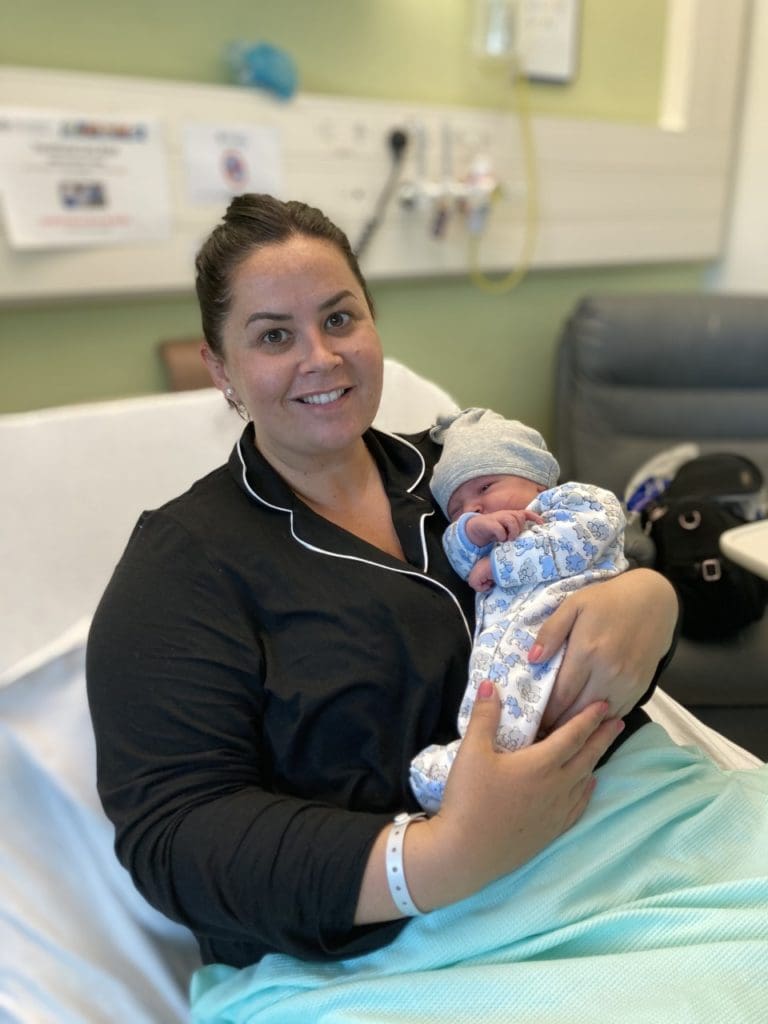In a first for Wales, Anne-Marie Leaman recently gave birth to baby Hudson using new climate-friendly gas and air technology. Cardiff and Vale University Health Board (UHB) is committed to embedding sustainability into healthcare systems, the use of the new green technology marks a significant milestone in reducing nitrous oxide emissions.
Nitrous oxide is commonly used in healthcare for anaesthetics but despite being a critical part of healthcare delivery, it is considered a harmful greenhouse gas. Studies show nitrous oxide has more than 265 times the global warming potential than carbon dioxide (CO2).
Entonox, commonly known as gas and air, is a combination of nitrous oxide and oxygen. In Cardiff and the Vale of Glamorgan, the use of Entonox is equivalent to emitting 4495 tonnes of CO2 every year which is comparable to driving 930 times around the world in a petrol car. Entonox Carbon Reduction Units which have been developed in Sweden are able to collect exhaled nitrous oxide and ‘crack’ it into nitrogen and oxygen which are deemed harmless.
Anne-Marie Leaman, said: “It’s important to do what we can collectively to reduce our impact on the environment and I’m delighted to have been able to switch from a traditional gas and air system to a greener alternative and play my part.
“I’d encourage anyone giving birth who requires gas and air to opt for this new system if it’s available. It’s great to see Cardiff and Vale UHB taking strides to become more sustainable.
“Thank you to all of the team who supported me throughout my pregnancy and labour, bringing baby Hudson into the world.”
Cardiff and Vale UHB has worked closely with patients and staff on the implementation of the Entonox Carbon Reduction Units. Patients and staff have demonstrated great enthusiasm and commitment towards reducing environmental impacts and embracing new methods of care.
The Entonox project forms part of wider activity to reduce the use of nitrous oxide across Health Board sites.
There are currently four nitrous oxide manifolds across the Health Board’s sites which are the typical method of storage. Findings by a Cardiff and Vale UHB multi-disciplinary project team have identified wastage from this type of system can be high due to leaks and loss of gas from the supply. The Health Board has trialled portable nitrous oxide cylinders at the Children’s Hospital for Wales as part of an individual pilot which has increased efficiency considerably, from 2.5% to 74%.
Following the successful pilot, the team scaled the pilot study across the organisation through The Spread and Scale Academy, with ambitions to share insights and encourage change across Wales. To date, the Health Board’s University Hospital Llandough site has fully decommissioned its nitrous oxide manifold and plans are underway to decommission the main manifold at University Hospital of Wales.
The Healthcare Without Harm Report says 5.6% of UK emissions are from healthcare settings and the NHS Wales Decarbonisation plan highlights anaesthetic gases reduction. The Health Board has projected savings of 1.15 million litres of nitrous oxide or 679 tonnes of CO2e each year which will play a huge part in making healthcare more sustainable in Cardiff and the Vale of Glamorgan and beyond.
Charlotte Oliver, Consultant Anaesthetist and one of the Clinical Leads for the project at Cardiff and Vale University Health Board, said: “I’m really proud of the hard work the team has put in to get us to this point, challenging norms of care that have been around for decades and allowing us to bolster our commitment to reducing our environmental impact. We recognise we still have a long way to go in our Shaping Our Future Sustainable Healthcare programme but are delighted with the progress we are making and the enthusiasm to adapt from our colleagues and patients.”

